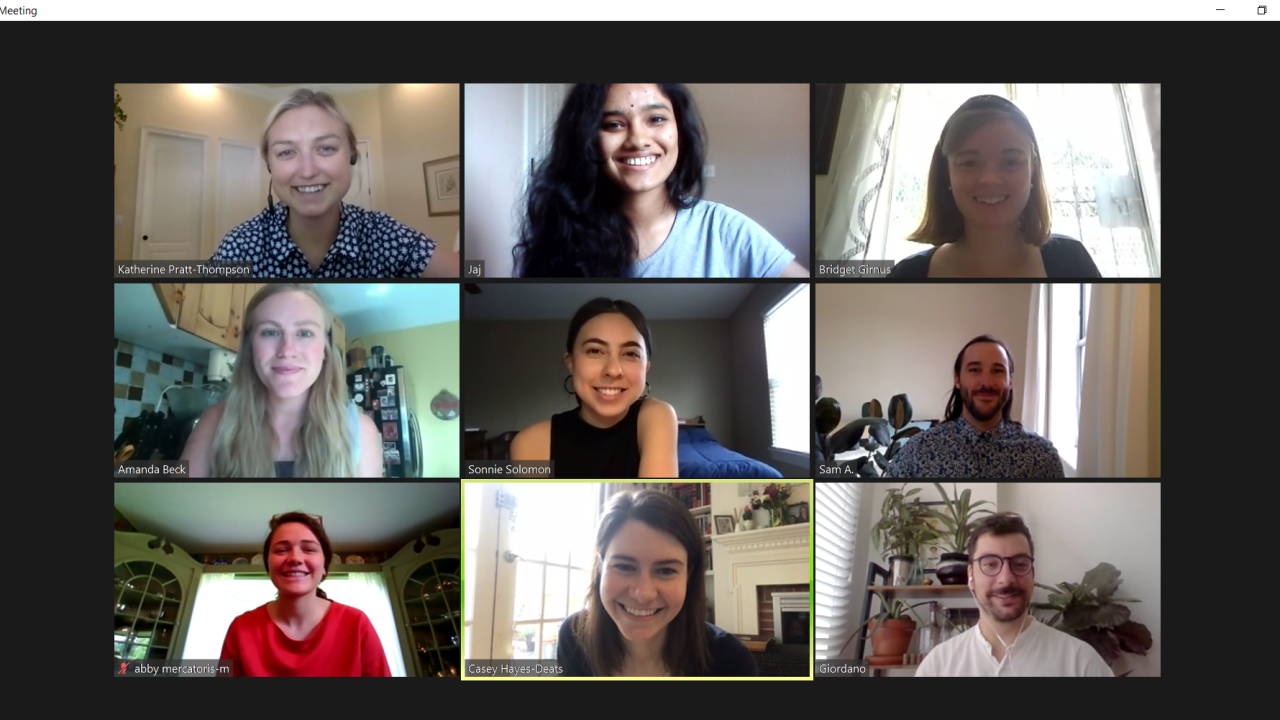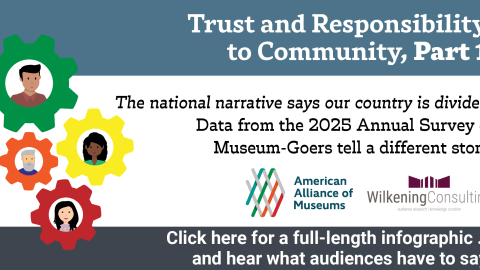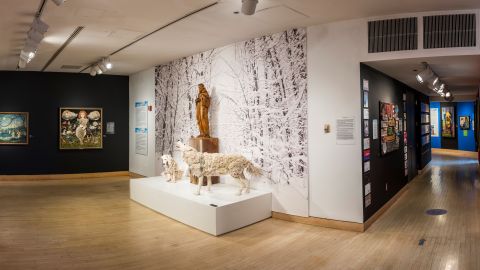
Amid the challenges of 2020, one of the most successful learning experiences for me was pivoting to a 100 percent remote internship program at the National Gallery of Art.
When I began planning to make the transition last March, I saw virtual internships as a temporary workaround during the pandemic. But after a broad research process where I absorbed best practices from museums, the corporate world, higher education, and associations, a switch went off in my head. I started to see that we should embrace the unique benefits of virtual internships as a way to move museums more fully into the twenty-first century.
While the virtual format does have some drawbacks—like the increased difficulty (or impossibility) of networking with colleagues and completing hands-on, collections-based projects—I believe they are ultimately a positive byproduct of the rise of remote work. In a post-COVID world, museums should continue to offer virtual learning experiences to complement traditional, in-person internships.
Here are three of the lessons I learned in transitioning to a virtual internship program and why I advocate for maintaining these experiences in the years to come.
Look outside of the museum field for guidance.
When I began researching virtual internships in the spring, I discovered that university and college career centers were the best source of information and resources. Early in the pandemic, these institutions provided resources on their websites about virtual internships, with targeted messaging for students and employers. It makes sense that schools would take the lead in going virtual to keep students connected to internships and employers, because they have a vested interest in workforce preparation and employment outcomes for their students.
I benefited a great deal from reading white papers and attending webinars sponsored by universities and associations, such as the National Association of Colleges and Employers (NACE). The University of Wisconsin-Madison’s Center for Research on College-Workforce Transitions (CCWT) also stood out for its contributions to the literature. Examples include “What do we know about online internships?” and “Supporting Black Interns through Vicarious Racial Trauma: Policy Recommendations for Employers and Postsecondary Institutions.“
One of the things I learned from this research is that virtual internships are not new. Schools have been connecting students to employers offering virtual internships for years, and have found that they have distinct benefits. For instance, in one webinar I watched, Tracey Lord, Program Director for Experiential Learning at Florida State University, described how virtual internships serve her student population, which includes a high percentage of first-generation college students. She explained that virtual internships eliminate the cost of relocating to a new city for an internship and allow flexibility for students to maintain part-time jobs, classes, and other commitments. (I will discuss the benefits of this increased access below in more detail.)
Connecting with colleagues at colleges and universities was key to learning best practices and accessing cutting-edge research. If I had only researched virtual internships in museums, I would not have learned as much.
Embrace transferable skills.
As I planned for the virtual internships, many museums were furloughing and laying off staff. I started to wonder, was this really the best time to be introducing students and recent graduates to the wonders of museum work, right when jobs in the field were disappearing? The uncertainty of this moment for museums and emerging professionals led me to think more critically about the transferrable skills we impart to interns. I worked to offer learning opportunities that will benefit the interns whether they pursue a career in museums or another field. Here are some of the transferable skills I emphasized:
Digital literacy
The nature of remote work demands that people be comfortable with computers and able to learn new platforms. The inaugural group of remote summer interns was not expected to be digital whiz kids, but they did need to be open to learning new technology. Throughout the nine weeks, interns gained proficiency in Microsoft Teams, Zoom, online research databases, and other platforms. Curatorial interns received virtual training for the museum’s collections management database and library, which enabled them to contribute to exhibition research and planning. An intern working with the education division helped set up the Google Classroom for the first-ever online Summer Institute for Educators: Art and Thinking. The skills interns mastered are things they can list and describe on resumes and will serve them well in a wide variety of careers.
Leadership
Virtual internships are also an opportunity to provide leadership experiences. In our program, for instance, one intern served as the lead intern, which meant she was responsible for creating weekly team-building activities for her cohort. Throughout the summer, she embraced her leadership role and worked to offer fun, accessible activities, both synchronous and asynchronous. Interns got to know each other by responding to weekly posts in the intern-only Microsoft Teams channel and attending a live, weekly social hour on Zoom. They played games, such as “would you rather” and online interactive Mad Libs, created crafts, and completed a virtual scavenger hunt about the museum’s collection. The lead intern’s efforts went a long way to ensure that, even though they never met in person, the interns ended the summer knowing the members in their cohort.
Online public speaking
Few skills are as transferable as public speaking. Although most students are required to give presentations in class and participate in class discussions, many are still learning how to give formal virtual presentations. This summer, all of the virtual interns were tasked with presenting an interactive art talk online via Zoom. The interns were divided into trios and matched with educators who shepherded them through the process. Educators provided support by reviewing outlines and leading practice talks. The interns supported each other by giving feedback during practice talks and technical support on the day of live presentations. The art talks resulted in interns gaining knowledge about the National Gallery of Art’s collection and confidence presenting live on Zoom. All of the interns improved their ability to communicate effectively about art and worked as a team to support one another. The experience was a highlight of the summer and represented a tangible accomplishment interns can talk about when applying for future internships and jobs.
Reflection for professional development
The NGA’s summer internship program kicked off on June 1, which coincided with the Black Lives Matter protests. In response to the heightened emotions and anxiety, I incorporated reflection into the internship program.
When I met with the summer interns in June, I talked with them about the importance of slowing down and reflecting on the internship experience and modeled some activities. I provided writing exercises (i.e., write a letter to your future self about summer 2020) and more creative prompts (i.e., sketch your at-home workplace, in words or a drawing). As a group, for ten minutes, we wrote a stream of consciousness. My colleague Lorena Bradford suggested this creative writing exercise. If you cannot think of what to write, she said, write “I don’t know what to write” over and over until something comes. The point of the exercise is to turn off the editorial voice and dispense with the need to create. After ten minutes, I asked, “What is one thing that surprised you about this activity?” Memorably, the intern I thought would be most resistant to the practice of reflection was first to volunteer to share.
Reflection for professional development is not new. Nursing and education students are introduced to the practice in school, for instance. However, in general, social-emotional learning is something educators tend to do less with mature audiences. That is a shame. Reflection allows learners to step back from their experience, develop critical thinking skills, and improve on future performance by analyzing what they have learned and how far they have come.
Time management
The transition from the classroom to the workplace does not include a syllabus. Instead, interns are expected to manage their work independently to meet deadlines. This can be a challenging learning experience under any circumstances, but especially in the virtual setting. While virtual interns may have the advantage of a flexible work schedule, they must learn to manage their time and multi-task without the benefit of in-person, observational experience, or the ability to ask questions in real time. Therefore, it is even more critical for them to develop an understanding of deadlines and expectations for projects.
This summer, I also saw how learning to leave work at five o’clock each day can be challenging for virtual interns eager to soak up all an internship has to offer. The ritual of closing the laptop and not checking email after the workday is essential to master, too. Completing a virtual internship signals to future employers that an intern can prioritize work responsibilities and balance home and work life, which matters because teleworking will likely continue long after the pandemic.
Think about access.
As museums are thinking critically about diversity and inclusion, virtual internships can help increase the pipeline of diverse museum professionals. Virtual internships break down barriers to participation in two ways. First, the format allows for flexible work schedules, which can be crucial for interns who may be students, caregivers, or people with disabilities. Second, for interns with limited financial means, virtual internships remove the economic burdens of having to relocate and pay rent on an intern stipend, if the museum is outside their home community.
This year, I experienced firsthand how virtual internships expand the pool of interns. In February, a first-choice candidate turned down our nine-month internship offer because she believed the cost of relocating would be too much, especially with student loans to pay off. But fast forward to March, when we converted in-person internships to virtual, and she enthusiastically accepted the offer. It was a win-win for the intern and the museum.
On the other hand, virtual internships may present barriers for some participants. Interns need to have the technical capability to complete projects, maintain contact to ask questions, and submit work assignments. A pre-program survey can provide valuable information about how prepared interns are for remote work. Do they have the necessary equipment, high-speed internet, desk space, and a quiet environment to be productive teleworkers? We sent out a survey to our interns, and their illuminating responses helped us be better prepared to support them. For instance, a couple of interns would be joining us from the West Coast, and needed live sessions to accommodate the time difference. Several of the interns had moved back in with family and were learning how to work from home. Some were also balancing part-time jobs, summer school, and caregiving responsibilities. Despite their unique living situations and schedules, none of these factors prevented them from fully participating in the virtual internship program.
In 2021, I look forward to welcoming a new cohort of 100 percent virtual interns. With this new iteration, I am excited to show interns the connection between classroom learning and the real world and help them focus on their futures. And I am convinced the virtual format can help museums do this better than ever.








